A mastery approach to maths PETER
SERIES
2 nd EDITION
CLARKE
EDITOR
Teacher’s Guide Foundation
2 nd EDITION
Editor: Peter Clarke Teacher’s Guide Foundation SAMPLEPAGES
Series
William Collins’ dream of knowledge for all began with the publication of his first book in 1819.
A self-educated mill worker, he not only enriched millions of lives, but also founded a flourishing publishing house. Today, staying true to this spirit, Collins books are packed with inspiration, innovation and practical expertise.
They place you at the centre of a world of possibility and give you exactly what you need to explore it.
Collins. Freedom to teach.
Published by Collins
An imprint of HarperCollinsPublishers
The News Building, 1 London Bridge Street, London, SE1 9GF, UK
HarperCollinsPublishers
Macken House, 39/40 Mayor Street Upper, Dublin 1, D01 C9W8, Ireland
Browse the complete Collins catalogue at collins.co.uk
© HarperCollinsPublishers Limited 2024 10 9 8 7 6 5 4 3 2 1
ISBN 978-0-00-864494-9
All rights reserved. No part of this publication may be reproduced, stored in a retrieval system, or transmitted in any form by any means, electronic, mechanical, photocopying, recording or otherwise, without the prior written permission of the Publisher or a licence permitting restricted copying in the United Kingdom issued by the Copyright Licensing Agency Ltd, 5th Floor, Shackleton House, 4 Battle Bridge Lane, London SE1 2HX.
British Library Cataloguing-in-Publication Data
A catalogue record for this publication is available from the British Library.
Author: Peter Clarke
Series editor: Peter Clarke
Publisher: Laura White
Product managers: Letitia Luff and Holly Woolnough
Commissioning editor: Rachel Houghton
Edited by: Sally Hillyer, Tanya Solomons and Catherine Dakin
Editorial management: Oriel Square
Cover designer: Kneath Associates
Cover illustration: Kneath Associates
Internal illustrations: Brett Hudson, Michelle Mathers, Mike Phillips, Jouve India Pvt. Ltd.
Typesetter: David Jimenez
Production controller: Alhady Ali
Acknowledgements
With thanks to all the kindergarten staff and their schools around the world who have helped with the development of this course, by sharing insights and commenting on and testing sample materials:
Calcutta International School: Sharmila Majumdar, Mrs Pratima Nayar, Preeti Roychoudhury, Tinku Yadav, Lakshmi Khanna, Mousumi Guha, Radhika Dhanuka, Archana Tiwari, Urmita Das; Gateway College (Sri Lanka): Kousala Benedict; Hawar International School: Karee Barakat, Shahla Mohammed, Jennah Hussain; Manthan International School: Shalini Reddy; Monterey Pre-Primary: Adina Oram; Prometheus School: Aneesha Sahni, Deepa Nanda, Pragyanam School: Monika Sachdev; Rosary Sisters High School: Samar Sabat, Sireen Freij, Hiba Mousa; Solitaire Global School: Devi Nimmagadda; United Charter Schools (UCS): Tabassum Murtaza; Vietnam Australia International School: Holly Simpson
The publishers wish to thank the following for permission to reproduce photographs.
(t = top, c = centre, b = bottom, r = right, l = left)
SAMPLEPAGES
Printed and Bound in the UK by Ashford Colour Press Ltd
This book is produced from independently certified FSC™ paper to ensure responsible forest management. For more information visit: harpercollins.co.uk/green
p 7t Rawpixel.com/Shutterstock, p 7b KAY4YK/Shutterstock, p 8tl Beloborod/Shutterstock, p 8tr ziggy_mars/Shutterstock, p 8bl DGLimages/Shutterstock, p 8br Boisvert/Shutterstock, p 23 Marius Pirvu/Shutterstock p 252 Shutterstock
The publishers wish to thank the following for permission to reproduce text:
‘A Counting We Will Go’, lyrics by Brian Haner, copyright © 2007 Music, Movement & Magination, Inc.; lyrics amended by Peter Clarke and used with the permission of Music, Movement & Magination, Inc. All rights reserved.
The publishers gratefully acknowledge the permission granted to reproduce the copyright material in this book. Every effort has been made to trace copyright holders and to obtain their permission for the use of copyright material. The publishers will gladly receive any information enabling them to rectify any error or omission at the first opportunity.
Extracts from Collins Big Cat readers reprinted by permission of HarperCollinsPublishers Ltd
All © HarperCollinsPublishers
Contents Introduction 5 Busy Ant Maths Foundation 2nd edition 5 An introduction to reception (P1 NI) ���������������������������������������������������������������������������� 7 About reception (P1 NI) children 7 The reception (P1 NI) teacher 7 The reception (P1 NI) environment 8 Activity stations ................................................................................................................................. 9 Components of Busy Ant Maths Foundation ������������������������������������������������������������ 10 Using Busy Ant Maths Foundation ���������������������������������������������������������������������������� 14 Planning teaching and learning 14 Managing a maths session 14 Features of a Busy Ant Maths Foundation Unit 16 Recommended teaching and learning sequence ........................................................................... 18 Developing number fluency beyond a maths session .................................................................... 18 Teaching young children maths 19 Concrete-pictorial-abstract (CPA) approach ................................................................................... 19 Thinking, reasoning and working mathematically .......................................................................... 19 Key concepts in reception (P1 NI) maths 21 Developing maths language 23 Learning objectives for Busy Ant Maths Foundation ������������������������������������������������� 24 Links between the learning objectives and units in Busy Ant Maths Foundation and the DfE (2021) Development Matters: mathematics statements for reception, and DfE (2023) Statutory Framework: Early Learning Goals in mathematics 25 Assessment ��������������������������������������������������������������������������������������������������������������� 28 Tracking children’s progress 28 Progress tracking grids 30 Teaching notes Unit 1: Numbers to 10 (A) ............................................................................................................... 37 Unit 2: Numbers to 10 (B) ............................................................................................................... 47 Unit 3: Position, direction and movement 57 SAMPLEPAGES
Unit 4: Length and height 66 Unit 5: 2D and 3D shapes 76 Unit 6: Numbers to 20 (A) 87 Unit 7: Addition ............................................................................................................................... 96 Unit 8: Subtraction ....................................................................................................................... 106 Unit 9: Patter ns and data 115 Unit 10: Number patter ns 124 Unit 11: Time 137 Unit 12: Numbers to 20 (B) ........................................................................................................... 147 Unit 13: Addition and subtraction (A) ........................................................................................... 157 Unit 14: Addition and subtraction (B) 167 Unit 15: Addition and subtraction (C) 177 Unit 16: Weight and capacity 187 Unit 17: Numbers beyond 20 ....................................................................................................... 198 Photocopy masters 211 Number fluency games and activities ���������������������������������������������������������������������� 281 Rhymes and songs 295 Generic games ��������������������������������������������������������������������������������������������������������� 307 SAMPLEPAGES

Busy Ant Maths Foundation 2nd edition Introduction
Busy Ant Maths Foundation 2nd edition has been completely revised and rewritten to reflect the curriculum and pedagogical standards of the Department of Education (DfE) (England) Statutory framework for the early years foundation stage (July 2023)and Development Matters – Non-statutory curriculum guidance for the early years foundation stage (July 2021).
The 2023 early years foundation stage (EYFS) framework seeks to provide:
• quality and consistency in all early years settings, so that every child makes good progress and no child gets left behind
• a secure foundation through planning for the learning and development of each individual child, and assessing and reviewing what they have learned regularly
• partnership working between practitioners and with parents and/or carers
• equality of opportunity and antidiscriminatory practice, ensuring that every child is included and supported.
The EYFS specifies requirements for learning and development and for safeguarding children and promoting their welfare. The learning and development requirements cover:
• the areas of learning and development that must shape activities and experiences (educational programmes) for children in all early years settings
Throughout the introduction, reference is made to both English/Welsh year groups, and ‘P’ groups in Northern Ireland.
Busy Ant Maths Foundation 2nd edition has been designed and written with the above requirements in mind and so supports the four EYFS principles that shape good practice in early years settings:
Every child is a unique child.
SAMPLEPAGES
• the early learning goals that providers must help children work towards (the knowledge, skills and understanding children should have at the end of the academic year in which they turn five)
• assessment arrangements for measuring progress (and requirements for reporting to parents and/or carers).
Children learn and develop in enabling environments.
Children learn through positive relationships.
Children learn and develop in different ways and at different rates.
All of the components of Busy Ant Maths Foundation emphasise, and provide guidance on, the importance of the cyclical nature of teaching in order to best promote learning and development.

The EYFS framework (2023) identifies seven inter-connected areas of learning and development: three prime areas and four specific areas.
5 Introduction
mssessA e n t Planning gnihcaeT • Promote learning • Raise attainment • Achieve mastery
Communication and Language
Personal, Social and Emotional Development Physical Development
Literacy Mathematics
A key aim of Busy Ant Maths Foundation is to support practitioners in planning a successful programme of work for the mathematics area of learning and development, in order to give children the best possible introduction to mathematics.
Children’s early mathematical development is about being confident and competent in learning and using key skills. However, it is also about providing children with the opportunities to see mathematics as interesting, enjoyable, relevant and worthwhile, and to develop positive attitudes and interests in mathematics, look for patterns and relationships, spot connections, ‘have a go’, talk to adults and peers about what they notice, and not be afraid to make mistakes.
The DfE Statutory framework for the early years foundation stage (July 2023) is the mandatory framework for all early years providers in England. It sets out the Early Learning Goals (ELG), which summarise the knowledge, skills and understanding that all children should have at the end of the EYFS – reception year (P1 NI).
The ELGs are not intended to act as a curriculum or in any way to limit the wide variety of rich experiences that are crucial to child development. Instead, the ELGs support teachers to make a holistic, best-fit judgement about a child’s development, and their readiness for Year 1 (P2 NI).
Understanding the World Expressive Arts and Design
and pedagogical approaches of the 12 mathematics statements for reception as specified in Development Matters, as well as the six mathematics ELGs from the Statutory framework (2023).
SAMPLEPAGES
Similarly, the DfE Development Matters – Nonstatutory curriculum guidance for the early years foundation stage (July 2021) provides a curriculum model to help schools design their own effective early years curriculum.
Busy Ant Maths Foundation provides a structure for teaching and learning mathematics, and a reference against which children’s attainment and skills development can be checked. It is based on a set of learning objectives, specific to Busy Ant Maths Foundation, which entirely reflects the content requirements
These learning objectives are taught and revisited through a series of 17 integrated units, each suitable for two weeks’ work and using popular topics and themes. The course supports children through clear lines of progression in all the prior learning they will need to move successfully into Year 1 (P2 NI).
The table on pages 24 and 25 lists the Busy Ant Maths Foundation learning objectives and units, while the tables on pages 25 to 27 show the links between the learning objectives and units, and the DfE (2021) Development Matters: Mathematics statements in Reception, and the Statutory framework (2023) mathematics ELGs.
Page 18 (Recommended teaching and learning sequence) offers a suggested scope and sequence through the 17 units. While following the order of the units will assist with progression, Busy Ant Maths Foundation offers a high level of flexibility, and schools and teachers should not feel constrained by the order in which the units are taught, nor the amount of time allotted to each of these units. The teaching and learning sequence should be viewed as a recommendation only. Individual schools and early years providers should adapt this sequence to reflect the requirements of their school/setting and the needs of their children.
The activities and experiences in each of the units in Busy Ant Maths Foundation include:
• adult-led activities (referred to as ‘Getting started’ and ‘Teaching’) such as group teaching and learning opportunities, participation in stories, rhymes and songs, and discussion of everyday experiences using mathematical language
6 Introduction
• explore and play activities (referred to as ‘Explore in groups’) such as imaginative roleplay, games and physical activities both in and outdoors.
For further details on planning, teaching and learning, and managing a maths session, refer to pages 14–18: Using Busy Ant Maths Foundation.
An introduction to reception (P1 NI)
About reception (P1 NI) children

Reception (P1 NI) children are creative and curious about the world around them. They are building a secure sense of self and finding out how to be with others and do things collectively. Their increasing ability to play collaboratively
What are their needs?
A cosy indoor place to feel safe, and the big outdoors to explore
A balance of different times in the day to play, relax and rest
is linked to their developing sense of fairness and understanding that their actions have consequences.
Reception (P1 NI) children learn through repeated cycles of actions in which they are able to experiment with different objects and patterns – moving things from place to place, covering objects, putting objects into containers, moving in circles, and throwing objects. As they investigate and experiment, they figure out how things work and develop essential problemsolving strategies.
SAMPLEPAGES
They enjoy loose parts play – playing with blocks, building, fitting things together and taking them apart. They love indoor and outdoor dynamic play like making music, dancing, using body movement to explore rhythm, saying and singing action rhymes and songs, digging, climbing and splashing.
Routines which mark the passing of time and provide a sense of security

The reception (P1 NI) teacher
Reception (P1 NI) teachers ‘listen with their eyes’, and see that expressions and movements are a true part of the child’s voice. They know when to stand back and let the children take
Access to a wide range of resources, including technological tools like computers and tablets
To be actively engaged in their own development and learning
the lead and when to extend a child’s learning by saying, ‘I wonder what would happen if…’. They give positive feedback and modelling. They offer a safety net, which allows children to take reasonable risks as they play.
7 Introduction
The reception (P1 NI) environment

When you enter a reception (P1 NI) classroom, there is usually a space for children to hang up their coats on their own hook, and a locker or shelf in which they can store their bags and outdoor shoes if used.
The classroom has desks, arranged in small groups, for drawing, painting and writing work. Each child should have their own seat in the group. This is the place to which they will return when asked to get ready for the next activity, for quiet time or to be counted. The teacher usually has a signal, like clapping three times, which lets the children know it is time to return to their seats. In some schools, there is a messy-play section with mud, clay, water or paint, and a place to wash up. There may also be a separate area for resting time.

to relax and for time out if they need a break from being with other children.

SAMPLEPAGES
Outdoor play is a vital part of children’s development. In the early years, children are highly active and are sometimes best able to demonstrate their achievements outdoors. They should spend at least three hours a day outside (not all of them at school), running, jumping, climbing, crawling, building, balancing and stretching. They should be digging holes, collecting stones and leaves, splashing in puddles, building forts and making dams.

The classroom has a reading corner – a carpeted area, sometimes with cushions, where the class or a group can gather for reading aloud or shared reading. This may be where the class’s small library is kept.
Children also go to the reading corner to look at books in their own time. They can also go there
Gross motor activities help to build muscle and coordination. There is a direct link between the development of coordination and motor skills and outdoor play. Reception as it is referred to in England and Wales or P1 in Scotland and Northern Ireland is sometimes known as kindergarten, especially in Europe. The word kindergarten means ‘a garden for children’. It was first used by Friedrich Froebel in 1840 to describe the school he envisaged, where children would learn through nature and the importance of play.
8 Introduction
Activity stations
Most reception (P1 NI) classrooms have different activity stations. There are suggestions for these below:
Activity stationMaterial and equipment
Sand station (sandpit or tray)
Sticks, combs and rakes for mark-making. Buckets, spoons, spades, containers of various sizes, sieves, moulds, shells, flags and other sand play toys.
Waterplay stationCommercial waterplay trolley or large bowls or trays of water placed on crates or low tables. Different-sized containers, watering cans, buckets, plastic bottles, sieves and colanders, corks, straws, sponges, plastic aprons.
Construction station
Large carpeted area or mat, storage baskets or containers, building blocks, interlocking cubes, recycled boxes and packaging, toy construction bricks.
Playdough stationPlaydough, base boards, playdough equipment (for example, rolling pins, shape cutters, modelling tools).
Painting and drawing station
Imaginative play station (Home corner)
Counting collections station
Other resources
Different-sized sheets of paper, crayons, coloured pencils, felt-tip pens, paint, brushes, aprons.
Puppets, soft toys, dolls, plastic tea cups and plates, blankets, fabric, dressing-up clothes and shoes, bags, toy cars, garage, a doctor’s set.
Small-world resources, e.g. people, animals and sealife, transport, doublesided counters, bottle tops, pebbles, pine cones, shells, matchsticks, lolly sticks, beads, buttons, corks, cotton reels, pegs, sorting trays, sorting rings, bowls, cups and pots, bags and containers for storage.
Additional notes
Cover the sandpit or tray after the children leave school in order to protect it from use by animals. It should also be cleaned regularly.
If possible, do waterplay outdoors where it doesn’t matter if the children spill or splash water. If your waterplay station is inside, you will also need towels and a non-slip mat. Change the water every day. Do not use glass containers. Never leave children unsupervised when they are playing with water.
SAMPLEPAGES
Other resources that are useful in a reception environment are:
• a display table linked to the current class theme, with objects the children can touch and investigate, for example, fruit and vegetables for the theme ‘Food’
• a weather chart on which the daily weather is recorded, displayed at child eye level (children can assist with this for the theme ‘Weather’)
The area needs to be large enough for a small group of children to work alongside each other.
There are many easy playdough recipes on the internet based on flour, sugar and salt. You can alternate playdough with clay.
Large sheets of paper are best for painting.
Create different environments linked to the current class theme for children to count, sort, compare and explore.
It is important to include an extensive counting collection, with different types of items sorted separately. Similarly, it is important to have a range of different sorting trays, hoops and other similar apparatus.
• the day and date displayed at child eye level
• an alphabet display, with a different letter focused on each week, as well as a collection of objects that start with that letter
• number bunting or a large number track showing the numerals 0 to 20, a picture to match each number (e.g. 17 dots below the number 17), and each number written as a word
• a noticeboard outside the classroom where you can post notices and information for parents and/or carers about what their children may need to bring to class.
9 Introduction
Components
of Busy Ant Maths Foundation
Teacher’s Guide


Photocopy masters (PCMs)
When using cards from a PCM to teach the whole class or large groups, it is best to print the PCM onto A3 paper.

A comprehensive and easy-to-use Teacher’s Guide. An introduction to reception (P1 NI) and thorough teaching notes with everything you need for successful maths sessions using all the resources. Guidance and proforma tracking grids for assessment, plus photocopy masters, number fluency games and activities, rhymes and songs and generic games. For a more detailed explanation of the features of a Busy Ant Maths Foundation unit refer to pages 16 and 17.
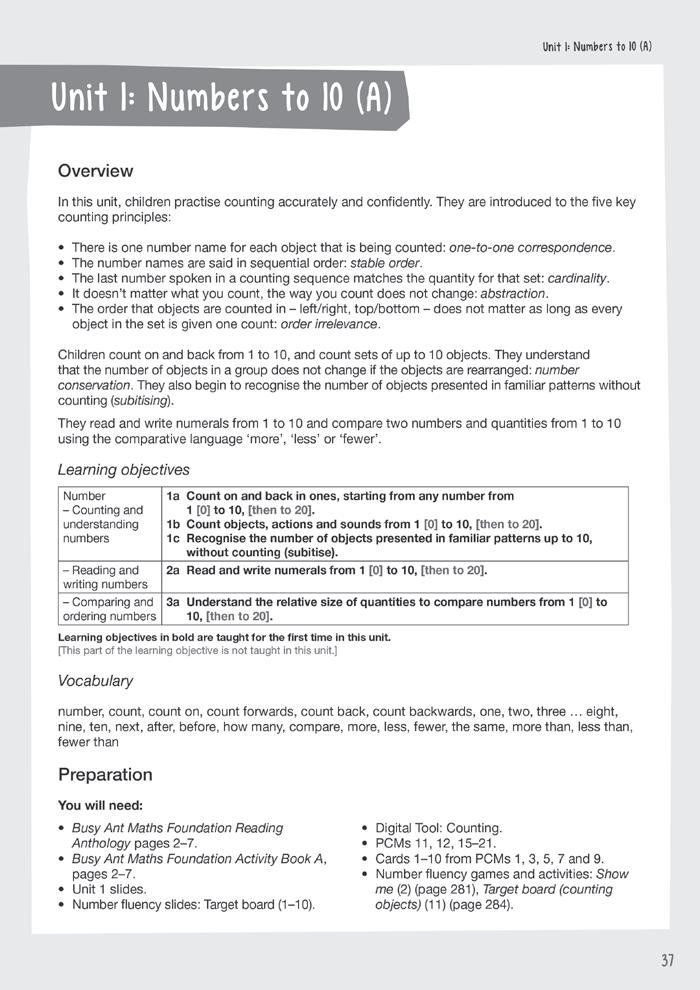
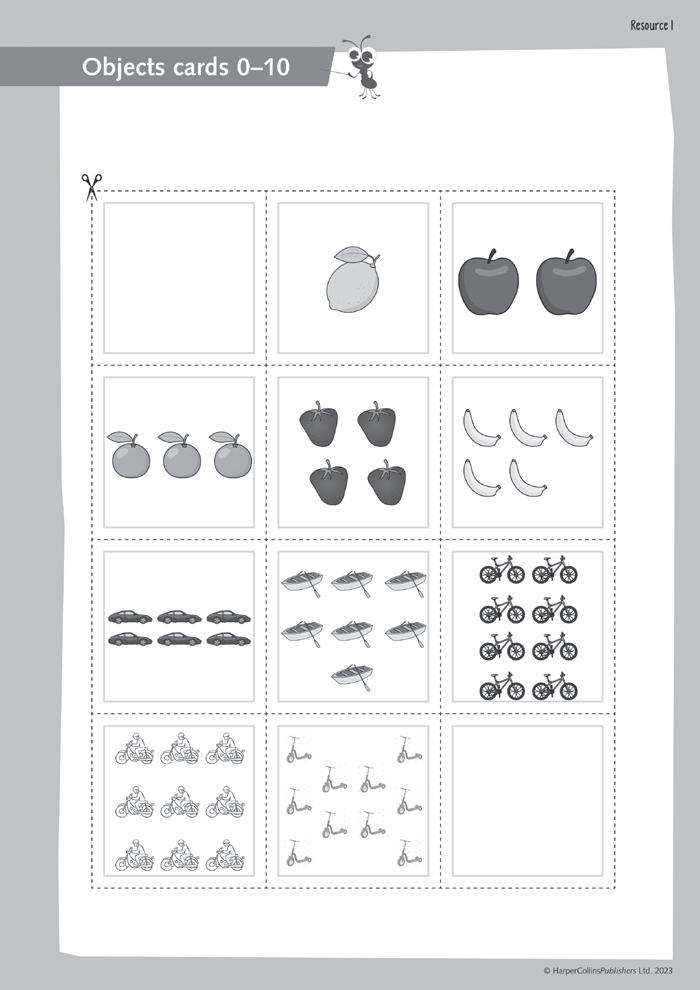
SAMPLEPAGES
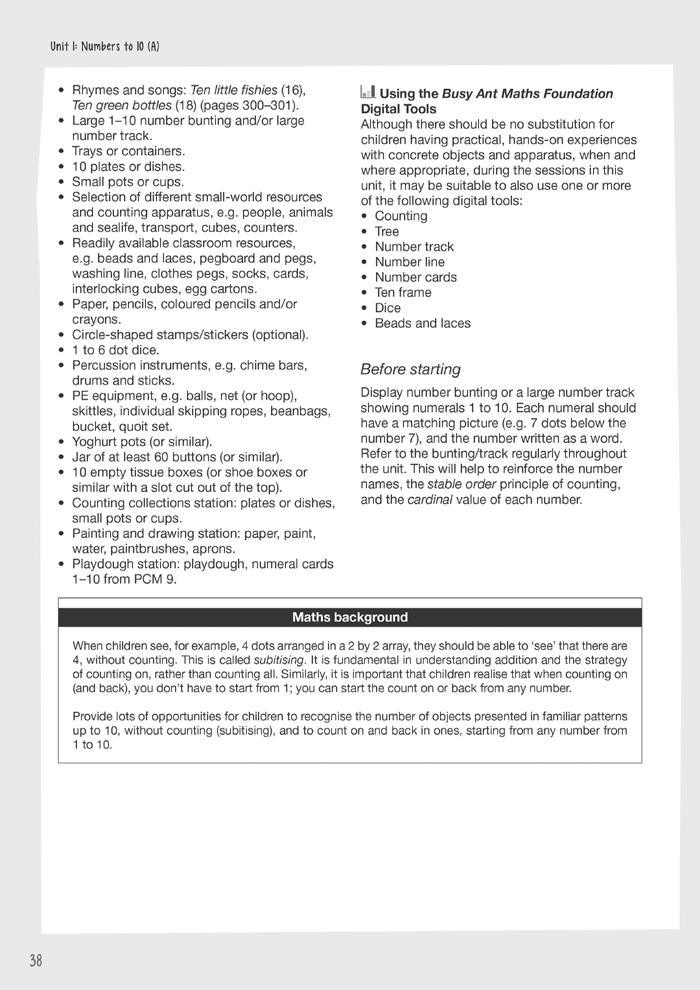

Busy Ant Maths Digital Subscription
The Busy Ant Maths digital content is at the core of the course and, along with the Teacher’s Guide, is the driving component of Busy Ant Maths Foundation.


The Busy Ant Maths Digital Subscription includes all the digital teaching resources provided by Busy Ant Maths, and includes the following features:
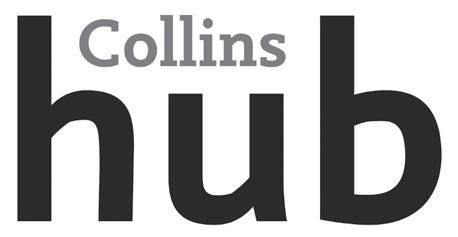
10 Introduction
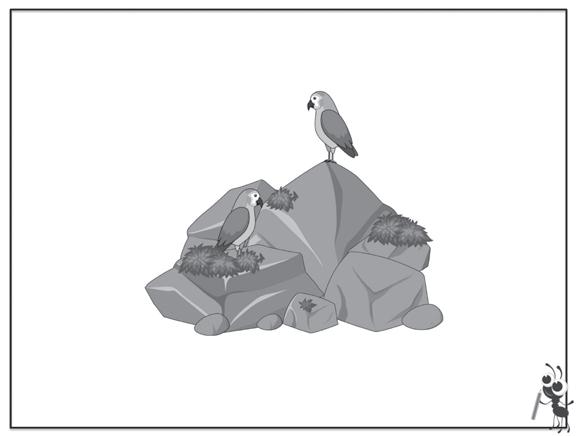
Digital Tools

Busy Ant Maths Foundation includes 19 flexible IWB teaching tools for whole-class or group demonstration.
PowerPoint presentations are provided for many of the sessions. They include core representations, models and contextual images that are designed to be displayed to the whole class or large groups on the interactive whiteboard (IWB) during the ‘Getting started’ and/or ‘Teaching’ phase of a maths session.
While reference is made within some units to specific tools to use in individual sessions, where appropriate, at the start of a unit a list of additional or alternative tool(s) is also included. These tools could be used, when appropriate, to demonstrate different mathematical ideas to the children.
However, it is important to remember that as useful as these tools may be for whole-class or group demonstration, there is no substitution for children having practical, hands-on experiences with concrete objects and apparatus.
StrandTool nameDescription of functionality
NumberCountingDifferent scenes and objects to assist with counting from 1 (or 0) to 5, 10 or 20 and for teaching addition and subtraction.
Tree Objects to assist with counting and for teaching addition and subtraction.
Number trackDifferent number tracks to assist with counting on and back and for teaching addition and subtraction.
Number lineAdaptable number line to assist with counting on and back and for teaching addition and subtraction.
Number cardsDifferent sets of number cards (numerals, dots and ten frames) to assist with counting and for teaching addition and subtraction.
Number squareDemonstrate and explore counting and number patterns from 1 to 100.
SAMPLEPAGES
Part-whole modelAdaptable part-whole models for composing numbers and for teaching addition and subtraction.
Bar modelAdaptable bar models for composing numbers and for teaching addition and subtraction.
Ten frameTen frame for composing numbers and for teaching addition and subtraction.
Base 10 Use to represent numbers using Base 10 (Dienes) equipment.
Bead sticksAssist with counting, and show the relationship between tens and ones.
Place valueDemonstrate place value using place value arrow cards.
Spinner Use the tool instead of, or in conjunction with, activities that require a spinner.
Dice Use the tool instead of, or in conjunction with, activities that require dice. Beads and lacesTo assist with copying, continuing and creating patterns and sequences.
11 Introduction
Slides
StrandTool nameDescription of functionality
MeasurementWeighingDemonstrate weight by weighing everyday items on a range of animated weighing scales.
Clock
GeometryPattern
Demonstrate the features of analogue and digital clocks, and explore time.
Copy, continue and create patterns and sequences of shapes to design a jumper.
Shape setAssist with identifying, describing, manipulating, composing, decomposing and sorting 2D and 3D shapes, and creating repeating patterns and sequences.
Other digital content
• Downloadable version of content from the Teacher’s Guide, including Introduction, Teaching notes for all 17 units, Photocopy masters, Number fluency games and activities, Rhymes and songs and Generic games.
• Editable short-term Weekly planning grids that link to the different teaching and learning components used in Busy Ant Maths Foundation.
• Audio files (mp3) of the Rhymes and songs and pages from the Busy Ant Maths Foundation Reading Anthology.
• In addition to the Rhymes and songs, there are a further six animated songs
• Eight interactive paired and individual pupil games for pupil consolidation.
• Digital version of the Progress tracking grids.
• Document showing the seven EYFS framework (2023) areas of learning and development that are developed within each of the 17 Busy Ant Maths Foundation units.
Activity Books
SAMPLEPAGES
There are three Activity Books in Busy Ant Maths Foundation, each covering one terms’ work.
• Units 1–6: Activity Book A
• Units 7–12: Activity Book B
• Units 13–17: Activity Book C
• The Busy Ant Maths Calculation Policy showing the progression of mental and written calculation strategies and methods used throughout the complete Busy Ant Maths course from Foundation to Year 6 (P1 to P7 NI), which schools are able to adapt and use as the basis of their unique calculation policy.
• Detailed and practical advice for planning the curriculum for mixed-age classes, which includes Busy Ant Maths curriculum comparison maps, medium-term mixed-age plans and Busy Ant Maths unit matching charts for Foundation (P1 NI) and Year 1 (P2 NI).
The Busy Ant Maths Digital Subscription is available on Collins hub. To find out more go to: collins.co.uk/BusyAntMaths
All Activity Book exercises reinforce and build upon the main teaching points and objective(s) of particular sessions in the Teacher’s Guide. The work is intended to allow all children in the class to practise and consolidate their newly acquired skills and understanding.
12 Introduction



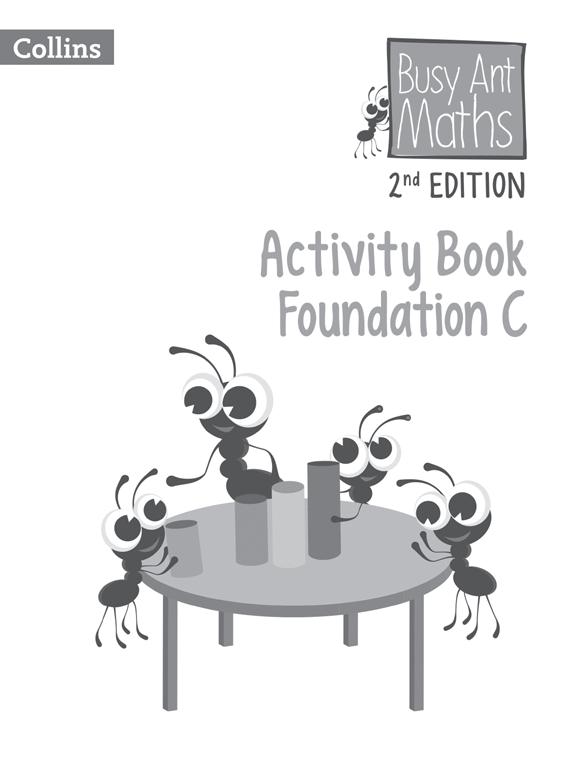
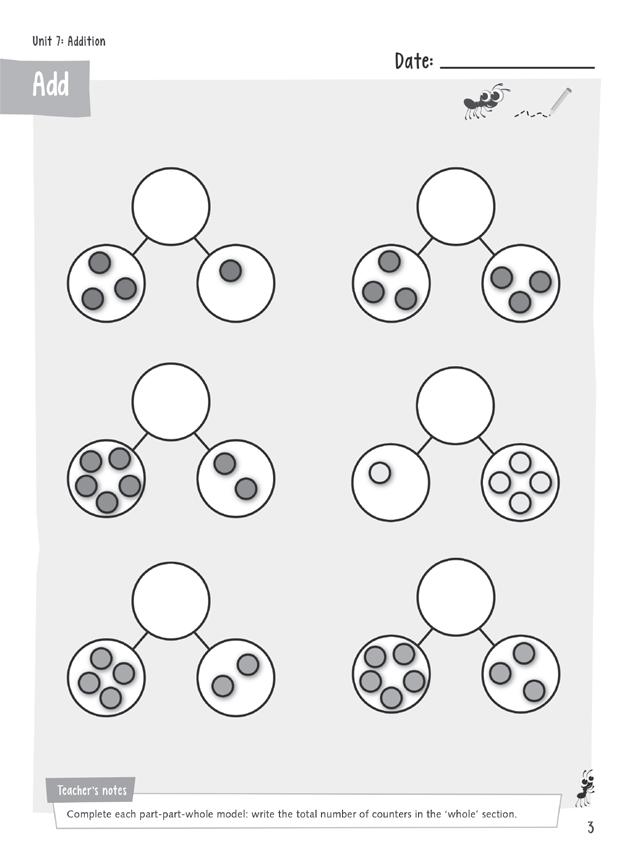
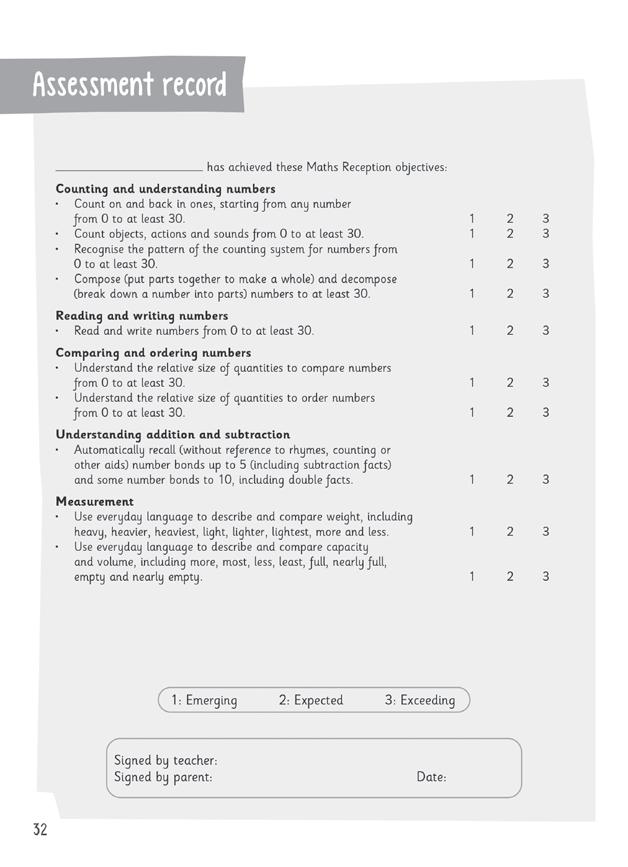
Full-colour activity pages practising maths skills and embedding knowledge. Each book includes its own tracking page for the skills and understanding covered as a child’s record of achievement.
Reading Anthology
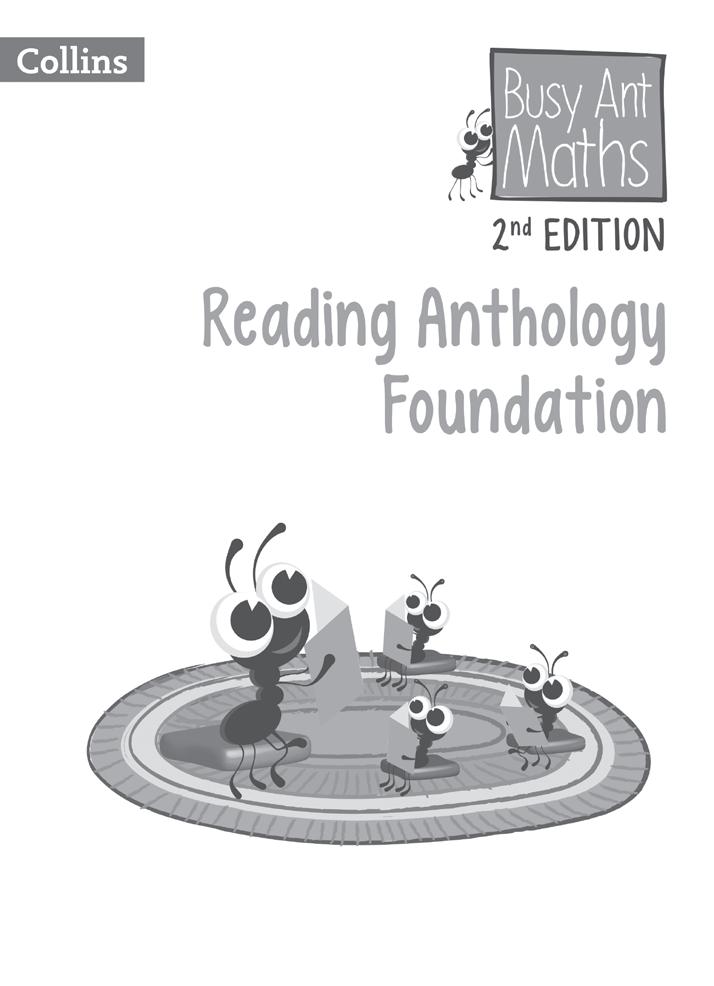
SAMPLEPAGES


A full-colour stimulus book with fun images for teaching concepts in most units.
13 Introduction
Using Busy Ant Maths Foundation
Planning teaching and learning
The activities in Busy Ant Maths Foundation take into account that young children need lots of opportunities to:
• explore, observe and discover things for themselves
• investigate and solve problems that are relevant to them
• practise and apply what they have lear ned.
You should dedicate time each day for purposeful mathematics activity. This should focus on supporting children to develop specific mathematical ideas and skills. Individual classes will take different lengths of time to learn the content of a unit. For this reason, each unit in Busy Ant Maths Foundation consists of eight sessions. You will need to make judgements, based on the level of understanding demonstrated by the children, as to how you will spread the eight sessions over the course of ten days. For some units, you may decide to teach eight sessions over the two weeks; while for other units, you may decide to repeat one or two of the sessions, or leave out some of the sessions altogether.
As you prepare for each unit, you will need to:
• make sure you are familiar with the activities in each part of the session
• decide on any adaptations to the activities that you need to make for your classroom setting
• gather, prepare and occasionally make the learning resources needed
the benefit of working with and learning from different peers.
Managing a maths session
Each session is divided into three parts: ‘Getting started’, ‘Teaching’ and ‘Explore in groups’. ‘Getting started’ and ‘Teaching’ combined should last approximately 15 to 20 minutes, and ‘Explore in groups’ a similar length of time. However, this will vary depending on the needs and abilities of your class, the content of the session, and when in the academic year the session is being taught.
SAMPLEPAGES
• lear n the songs, rhymes and games you will use well enough so that you do not need to refer to the written words or instructions during the session.
Grouping the children
For the ‘Explore in groups’ activities you will need to divide the children into groups.
At this age children should not be grouped by ability. Social grouping is far more beneficial and important in ensuring active learning for all children. It is a good idea to change the groups once or twice a term so that the children get
As children become more familiar with the structure of a session, they will increasingly be able to self-manage the transitions between the different parts.
Towards the end of reception (P1 NI), teachers could introduce a brief plenary at the end of each session. This will help to prepare children for the more formal lesson structure they may encounter in Year 1 (P2 NI).
About ‘Getting started’
These activities are teacher-led. You will usually work with the whole class. However, depending on how your class is structured, you may wish to repeat the activity several times throughout the day to different groups of children. These activities:
• get the session off to a clear start and focus children’s attention on maths
• may be used to quickly check what children already know about the topic you are about to teach
• may begin by:
– discussing pages from the Reading Anthology
– singing a song or saying a rhyme
– playing a Number fluency game or activity�
About ‘Teaching’
The ‘Teaching’ activities are teacher-led. You will usually work with the whole class. However, depending on how your class is structured, you may wish to repeat the activity several times throughout the day to different groups of children.
14 Introduction
These activities:
• teach children a specific mathematical concept or skill, or consolidate previous learning
• include appropriate questions to take learning forward and check understanding
• should involve all children actively participating.
About ‘Explore in groups’
For this part of the session the children are in groups at the activity stations, and work either independently or with adult support. The activities:
• encourage children to take their learning further and apply it in a new or different way
• have often been designed for the children to do independently of an adult
• should be led by the children, and any adult input should focus on observing, supporting and extending children’s thinking
• often do not require collaborative group work even though the children may be seated in groups
• encourage conversation and discussion between the children as they work
• include Activity Book pages for some sessions, which should be completed with adult support.
Some have ‘(adult-led)’ after them. These activities may benefit from an adult working closely with the children. This may be due to the complexity of the activity, or because intervention will help to develop conceptual understanding and mathematical language.
Some things to consider:
are used in a session. Use your professional judgement to decide how many activities to set up, and which activities will best meet your children’s needs and abilities. You should also draw on your own repertoire of tried-andtested activities.
Always supervise the children carefully. Be extra vigilant if they are using small parts.
Note
It is not necessary for children to read the words in either the Anthology or the Activity Books Use these as read-aloud resources and read the words to the children, sometimes inviting them to try to predict what the words say when you have given sufficient clues to help them make reasonable guesses.
SAMPLEPAGES
• The activities could be set up just for use during the maths session, or could remain for part or all of a day for children to access.
• An adult could work with the children one day on an activity, then put out the same resources for ‘free play’ on other days.
• There should be no expectation that all children will complete all of the activities in a particular session. Although children should be encouraged to explore the activities for themselves, adults should also direct individual children to the activities they feel are best suited to their needs and abilities.
• There is no expectation that all, or indeed any, of the ‘Explore in groups’ activities provided
Introducing a plenary
Towards the end of the reception year, you could consider introducing a plenary at the end of each session. A plenary is teacher-led. You would usually work with the whole class, following the ‘Explore in groups’ activities. The purpose of a plenary may be to:
• allow children to share what they have done or learned
• summarise the main teaching points, key facts, ideas and vocabulary
• make links with work in other subjects
• address common difficulties and misconceptions
• assess progress through the effective use of questioning
• identify next steps.
The role of the teaching assistant
Teaching assistants (or a second teacher) can support you and the children in the following ways:
• Helping to keep all the children focused during whole-class ‘Getting started’ and ‘Teaching’ activities.
• Helping children to complete Activity Book pages during ‘Explore in groups’.
• Assisting children who are working at the activity stations so that they do not disturb you while you are working with other children.
15 Introduction
• Gently helping to refocus children at the activity stations if needed. This can be done by finding out from the child what their intention is, then relating this back to the session topic. For example:
Teaching assistant: That looks interesting� What are you painting?
Child: I‘m painting a picture of a doll�
Teacher assistant: That’s interesting� Remember we were looking at things that slide, roll, turn, bend or stretch� Does a doll do any of those things? When you’ve finished the doll, could you paint a toy that rolls?
• Leading (or repeating) the ‘Getting started’ and/or ‘Teaching’ activities in one or more sessions so that you can focus on observing the children for assessment purposes.
Features of a Busy Ant Maths Foundation Unit
Summary of different learning opportunities in the unit
Unit-specific learning objectives that feed into the learning objectives for the Busy Ant Maths Foundation course
Words introduced and/or used in the unit

SAMPLEPAGES
A list of resources needed for the unit


List of experiences, knowledge, skills and concepts that are prerequisites for learning in this unit. This list is particularly useful for diagnostic assessment.

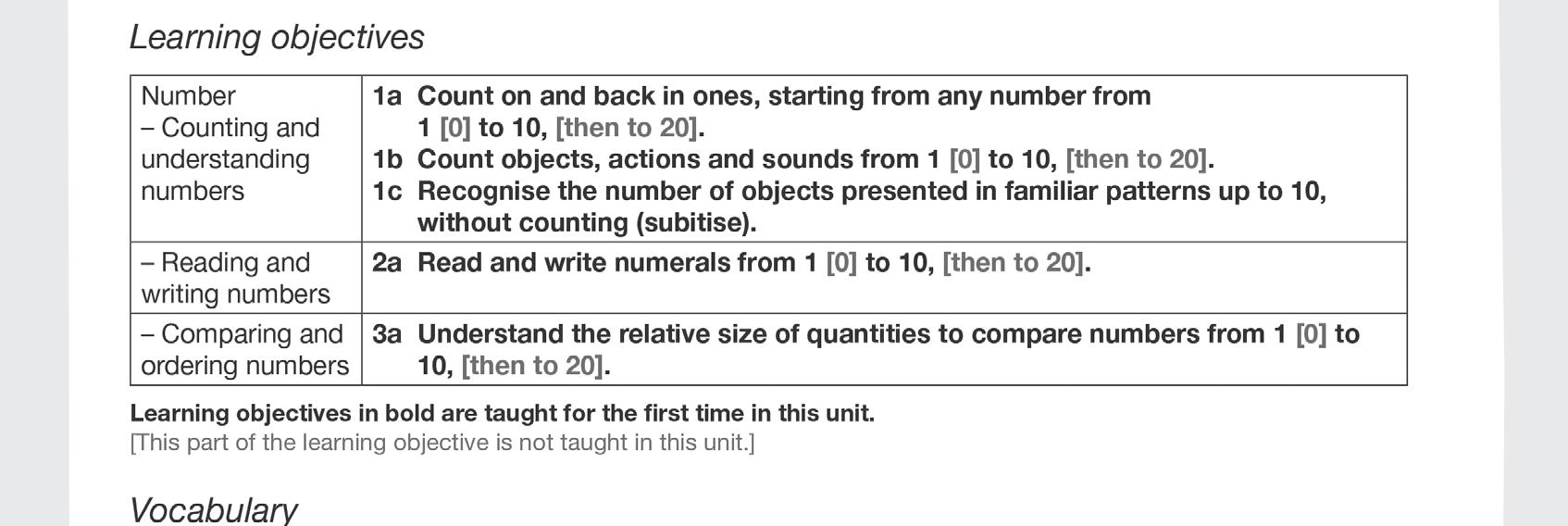






16 Introduction








A whole-class teaching activity, broken down into clear steps with suggested statements and questions to support you in achieving the purpose of the session
Useful notes of things to consider before starting the unit.
Session number and title along with a brief description of the purpose of the session
SAMPLEPAGES
Taking the learning further by exploring and practising individually, in pairs or in groups
A list of resources that you will need to gather and/or prepare for use during the session
Specific preparation needed prior to the session and/or whole-class activity ideas for introducing the session
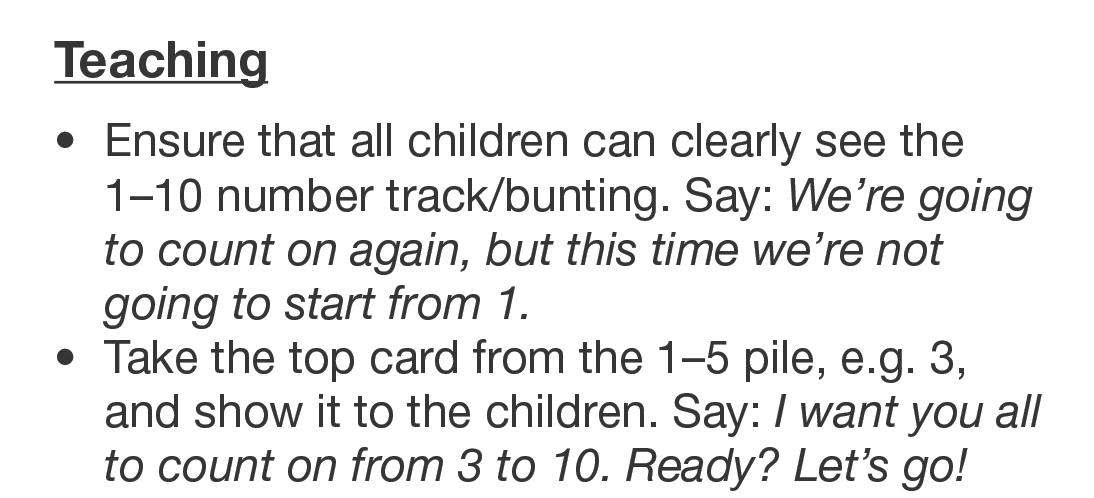



What you should look for in terms of achievement or understanding in this unit


17 Introduction
Recommended teaching and learning sequence
The table below shows the recommended teaching and learning sequence (often referred to as a medium-term plan) for the 17 units in
Weeks
Weeks 3 and 4 Unit 2:
Busy Ant Maths Foundation. It is based on an academic year of three terms, each 12 weeks long. However, the units can be taught in any order to best meet the requirements and needs of individual schools, teachers and children.
SubtractionUnit 14: Addition and subtraction (B)
Weeks 5 and 6 Unit 3: Position, direction and movement Unit 9: Patterns and dataUnit 15: Addition and subtraction (C)
Weeks 7 and 8 Unit 4: Length and heightUnit 10: Number patternsUnit 16: Weight and capacity
Weeks 9 and 10 Unit 5:
Weeks 11 and 12 Unit 6: Numbers to
Developing number fluency beyond a maths session
(A)Unit
It is important to find other opportunities throughout the day to create meaningful ways for children to use, practise and apply maths. This includes highlighting maths at various times of the day such as registration time, circle time, transitions, snack times, mealtimes and tidying up, as well as during play, and in other curriculum areas. For example, you could engage children in mathematical discussions, sing rhymes or songs, discuss pages from the Reading Anthology, or play a game or activity to develop number fluency�
SAMPLEPAGES
Busy Ant Maths Foundation includes a bank of Number fluency games and activities (pages 281–294). They help to reinforce key mental maths skills such as counting, comparing and ordering numbers, and addition and subtraction. These games and activities are adult-led and designed to be used with the whole class or a large group of children. They require no, or very few, resources, and are all oral activities rather than written. Each game or activity is designed to last no more than 10 minutes.
Many of the activities include different versions for additional variety and choice. They also allow for adaptations to make activities easier or more challenging, or to broaden
Numbers to 20 (B)Revision and consolidation
the activity to include other related concepts and skills.
Use the Number fluency games and activities often to continually revise and rehearse number concepts and skills, and to make sure the activities stay ‘alive’ in children’s minds. The more familiar the activities become, the more confident children will feel. Although they may not realise it, they will be gaining fluency, honing their skills and improving their understanding of maths.
The activities could be used:
• as part of ‘Getting started’ to introduce a maths session
• at the end of the maths session to bring the session to a close – perhaps as part of a plenary
• at the start of the school day or just before home time
• before or immediately after play
• with quick-finishers while waiting for other children
• while waiting to go to assembly or similar
• at any free moment during the day
• with families, the instructions and any resources having been sent home.
18 Introduction
Term 1 Term 2 Term 3
Unit 1: Numbers to 10 (A)Unit 7: Addition
1 and 2
Unit 13: Addition and subtraction (A)
Numbers
10
to
(B)Unit 8:
2D and 3D shapesUnit 11: Time Unit 17: Numbers beyond 20
20
12:
Teaching young children maths
Busy Ant Maths Foundation is written to reflect the importance of:
• starting from what children know already and helping them to move their thinking forwards
• children learning the fundamental principles of an idea and making connections between different ideas
• focusing on the process of learning, rather than the end product of it
• developing children’s thinking, by asking them questions and encouraging them to ask questions of their own
• lear ning through discovery and problem solving
• using collaborative, as well as individual, activities, so children can learn from each other
• evaluating the level of a child’s development so suitable tasks can be set.
Concrete representation
The child is first introduced to a concept using physical objects. This hands-on approach is the foundation for conceptual understanding.
Concrete-pictorial-abstract (CPA) approach
Children can find maths difficult because it is often abstract. Busy Ant Maths Foundation follows the CPA approach which builds on children’s existing knowledge by introducing new concepts using physical objects or practical resources and equipment.
The CPA approach involves moving from concrete materials, to pictorial representations, to abstract symbols and problems. Deep understanding of a concept is achieved by going back and forth between these representations and making children aware of the connections between each one.
SAMPLEPAGES
Pictorial representation
The child has understood the hands-on experiences and can relate them to images, such as a picture, diagram or model.
Abstract representation
The child is now capable of using numbers, notation and mathematical symbols to represent the concept.
Thinking, reasoning and working mathematically
Mathematical development does not only involve conceptual understanding, knowledge and skills across a range of maths topics. It also involves being able to think, reason and work mathematically. This means encouraging children to:
• actively engage with their lear ning
• talk with others, and be able to explain their ideas
• develop reasoning skills such as logical thinking
• try to make sense of ideas
• build connections between different facts, skills and concepts
• gain meaning and satisfaction from their maths learning
• view the world in a mathematical way
We do not want children to simply follow instructions and carry out processes that they have learned. We want them to know why the processes work and what the results mean. We want them to begin to see how maths applies to the real world and also to develop the skills needed to become independent mathematicians.
19 Introduction
9 36





















































